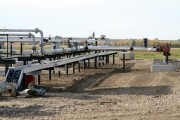On Oct. 27, the Pembina Institute’s Janetta McKenzie appeared as an expert witness at the House Environment and Sustainable Development Committee. Her full opening remarks are below.
In investigating the efficacy of Canada’s Emissions Reduction Plan, today I’d like to highlight two sectors whose emissions have changed dramatically over the last 20 years. I believe they tell a story of how strong, durable climate policies can work, without damaging industries.
First, Canada’s electricity sector has achieved a massive reduction in greenhouse gases, while growing its output. The sector has reduced 68 million tonnes, or 60 per cent of its carbon emissions, over the last 20 years, while increasing generation by 10 per cent.
On the other hand, the oilsands—the handful of companies in Alberta where bitumen is produced—has seen a 55-million-tonne increase in emissions since 2005. An increase of over 150 per cent.
The difference is simple: policy. The electricity sector responded to clear, long-term climate policies. Ontario began its phaseout of coal-fired power in 2003 and, building on that success, in 2012 then-prime minister Stephen Harper mandated a nationwide coal phaseout by 2061. Federal and provincial governments of different stripes built on that commitment resulting in regulations that sought to eliminate coal emissions by 2030 nationally, while giving provinces flexibility to meet that goal, and industry the runway to invest in other forms of electricity generation.
In Alberta, despite protestations that it couldn’t be done, in 2024 the last coal-fired power plant went offline ahead of schedule, despite coal powering 60 per cent of the grid just a decade before. Meanwhile, Alberta was flooded with billions of dollars of private investment in wind and solar projects, from which local governments collect millions of dollars annually in municipal tax revenues.
In other words, co-ordinated coal regulations are a prime example of a durable, predictable climate policy that companies can use to make long-term investment decisions.
It’s also a reminder that good climate policies don’t only reduce emissions—they show the world we are open for business for low-carbon investment. Globally, clean energy investment now outnumbers fossil fuels at a rate of two to one. Reinforcing Prime Minister Mark Carney’s recent statement that climate action is not simply a moral duty, but an economic imperative.
Now let me talk about the oilsands. In contrast to electricity generators, oilsands companies have not yet been subject to policy, either federal or provincial, that has placed an effective check on their overall pollution. Despite all the rhetoric about climate policies supposedly damaging the sector, oilsands production and emissions are in fact at all-time highs.
The oil and gas industry overall is now responsible for one third of Canada’s emissions—though only one-20th of our GDP.
For the oilsands, and for all sectors, we need strong policies guided by clear targets and predictable timelines that investors have confidence in.
Conversely, as we have seen south of the border, whiplashing policies are extremely damaging to industries, suppliers and workers.
Industrial carbon pricing is Canada’s best tool for driving innovation in high-emitting sectors like the oilsands. It has enjoyed the support of heavy industry—including oil and gas executives—for well over a decade, because of how it slowly and predictably gets stronger, allowing them to plan out more and more investment in decarbonization over time.
Unfortunately, Alberta has recently taken backward steps that weaken its industrial price, despite the fact that complying with the current system costs oilsands firms just a few dollars on the barrel. If what we want is a cleaner, future-proofed oilsands—or anything approaching “decarbonized barrels”—then strong industrial carbon pricing systems efficiently channel millions of dollars of private capital towards that goal.
Finally, the fact that we are not yet on track to meet our 2030 climate targets does not mean the Emissions Reduction Plan has failed. Measures such as industrial carbon pricing, clean electricity regulations, and electric vehicle sales standards are long-term measures whose benefits will only be achieved if they are given the time and stability to do so.
And, much like preparing for a marathon, where every training run you do improves your fitness, every tonne we don’t emit, and every low-carbon investment that is made improves our climate competitiveness.
Climate policy and economic policy are not at odds; rather, they are intrinsically linked. We need a fighting fit economy, where we can build world-class clean tech supply chains and make the low-carbon products other countries want.
But, as the contrasting examples of the electricity and oilsands sectors show, we won’t get there without long-lasting regulations and policies investors can work with.






